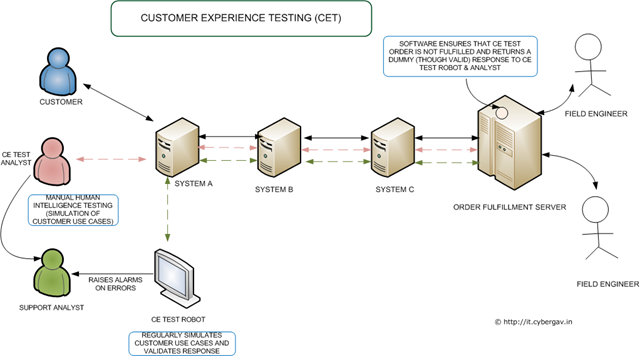Is service fine? What’s the impact to service? These are some of the key questions often asked by IT management in relation to their company’s IT services. In many cases, attempts are made to answer these questions by checking various system health monitors. In rare cases, these questions can be answered accurately by directly asking the customer(s) (although this will give an indication that you’re not in control). So, how do we know a customer’s experience of an IT service? The simple answer – by putting yourself in the customer’s shoes and trying to do what he/she does when using the service. However, implementation of this “customer experience” is not always straightforward, especially in enterprises having complex IT systems. Given below, is an illustration of Customer Experience Testing (CET).
CET is testing a product or service from a customer perspective. CET contributes greatly towards helping you provide an excellent customer experience for your product or service.
Why would Organizations avoid CET?
- Time
- Money
- Complexity
Time and money are the primary reasons why some organizations don’t implement CET even for business-critical services. Some organizations are put off by the complexity of their IT systems. However, this is a big mistake, because if CET is designed and implemented properly, it will actually save time and money.
How do you implement CET?
Design CET: CET is not just a process – it’s also a solution and so must be catered to in solution/system/end-to-end designs. A couple of reasons often given for not testing a particular service like a customer would do, are lack of test data and lack of a process for backend systems/implementers to identify a test. A few years ago, my colleagues and I were working on a problem with the payment fulfilment on a telecom giant’s website. Quite a few customers had reported problems with certain shopping journeys on the website. We wanted to simulate the problem and troubleshoot, but we did not have credit/debit card details to do so and staff were apprehensive of using their own cards due to the cumbersome process involved in getting a refund. We eventually fixed the problem, but had to rely heavily on customer feedback and that would not have made the customer comfortable. If we had test data and an end-to-end CET solution to place an order, then we could have been proactive and identified the fault before the customer reported it and we would have been able to fix the problem confidently and quickly and provide excellent customer satisfaction.
Know your use cases: A well-designed CET solution will use a CET Test Robot – a system that automates interaction with your product or service. In order to ensure that the CET test robot simulates a customer’s interaction with your product/service as closely as possible, you must know all your product’s use cases (what your product/service is designed to cater to) and setup the test robot to execute the use cases and validate responses regularly. Depending on your customer profile, using more than one CET robot and locating them across various locations in which your product/service has customers will provide you a better idea of customer experience.
Know your customer interaction: No matter how much time you spend on identifying use cases, at times, a customer will interact with your product/service in a way that you least expect (and consequently not covered by your use cases). So, how do you simulate these customer interactions in your CET testing? Well, you cannot simulate what you you cannot see. So, you need to know how your customers interact with your product/service. That’s why a solution which records customer interaction across all systems enabling a product/service must be implemented. This solution is sometimes part of “MIS” or “Business Intelligence” initiatives within organizations.
Know your customer: Machines can never completely replace humans (at least I’d like to think so!). While CET Test robots automate use case tests and MIS solutions record customer interaction, there is the possibility of not covering/recording every possible customer interaction. So, that’s why human intelligence is a also a key part of CET Testing – a CET Test Analyst. Rather than just execute a document of standard use cases and recorded customer interactions, the test analyst must think “out-of-box” and try to test the product/service as if he/she were a customer using that product/service. To enable this, the test analyst must work closely with the Support staff (and the customers) to understand the various problems reported by customers and customers’ inclinations. Over time, an experienced CET test analyst will be able to test an almost exhaustive list of customer interactions, thereby playing a vital role in ensuring customer satisfaction.
Use Dashboards: It will be enormously useful to feed the results of CET testing performed by robots and analysts to a dashboard application, so that at any time, the service’s stakeholders can view the status of various services, closely, if not accurately reflecting the usability of these services by the customers. To be useful, the dashboard must be simple, clear and provide the required information about services in an instant to its viewers. You may also choose to make such dashboards public so that in addition to the maintenance pages, you can provide one clear view of the status of all the services your organization provides.
What are the benefits of CET?
-
Tests the end-to-end business process from a customer perspective
-
Gives you a good idea (almost WYSIWYCS – What you see is what your customer sees) of the customer’s experience of a product/service at all times
-
Enables you identify problems with a product/service quickly, take proactive action to notify customers and fix the problem
In large enterprises, CET may not be easy to implement. However, given its huge benefits, CET is a must-have for customer-centric organizations and is definitely a worthwhile investment.

